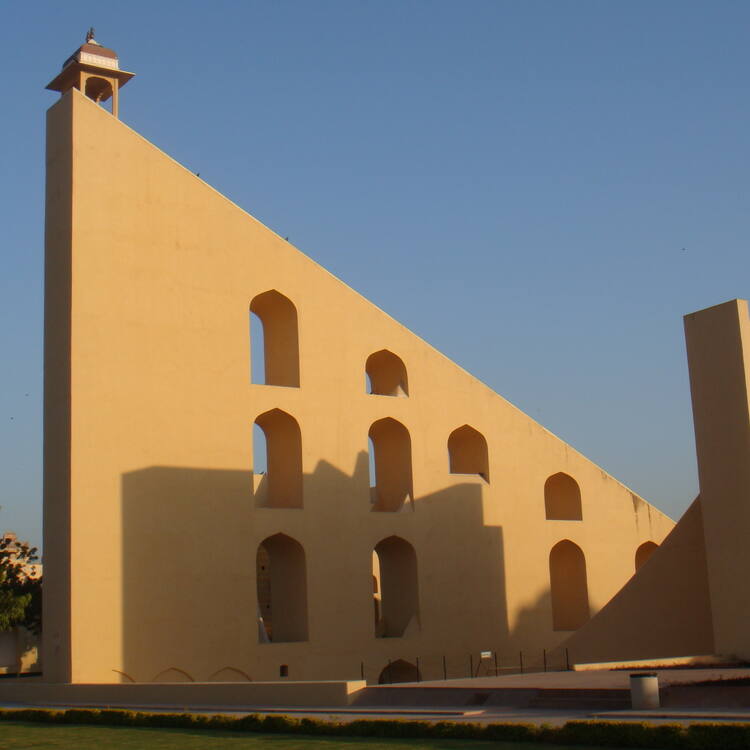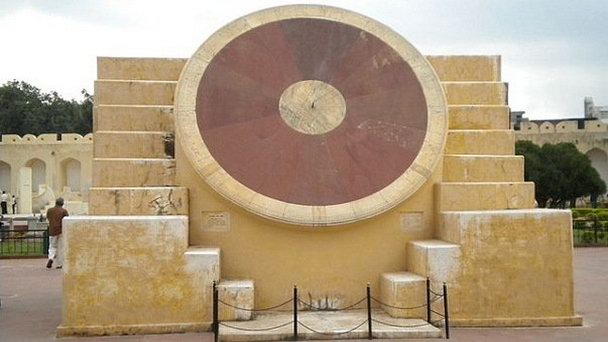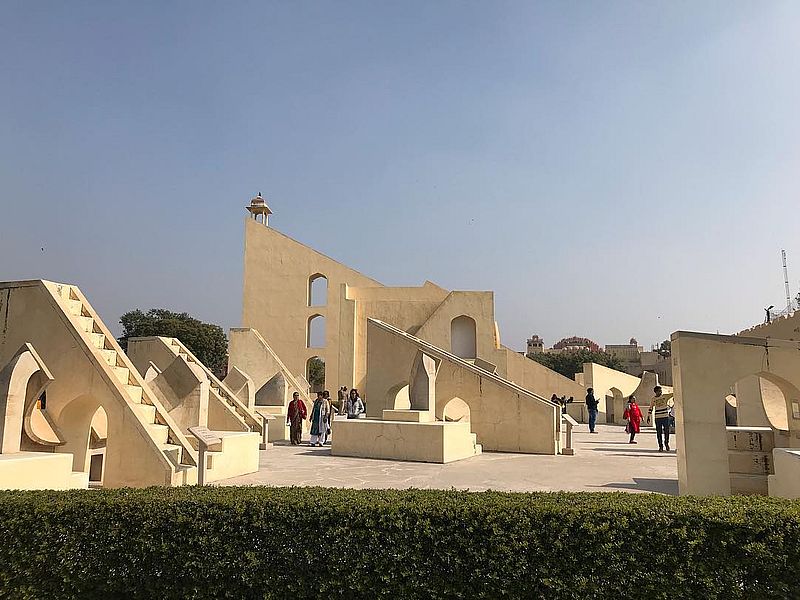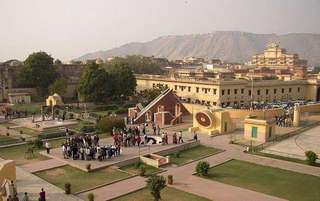Jantar Mantar Jaipur – Observatory Of Sawai Jai Singh
Jantar Mantar is a perfect place for those of us who loved Maths and Calculations at school. Standing at the observatory makes you feel as if the small instruments of your geometry box have suddenly taken a giant avatar. The semi-circles remind you of the D, the triangles remind you of their plastic versions and the markings on the instruments remind you of the scale. Some instruments remind you of the rotating globe. Well you never know, our school geometry box may have been a miniature version of instruments at Jantar Mantar. After all, Jantar means Yantra or Instrument, and Mantra means Calculation – is that not what our geometry box helped us with?
What is Jantar Mantar?

It is one of 5 observatories made by Raja Sawai Jai Singh. The other observatories are in Delhi, Varanasi, Ujjain & Mathura. The one at Jaipur is the last one and hence probably the best one of the lot. Built-in early 1728 CE at Jaipur, it underwent renovation work at the turn of the 20th CE. Records of this can still be seen on the walls including the names of the astrologers who validated the readings.
All the instruments are in stone, marble, and brass.
It is located next to the Jaipur City Palace and just behind the famous Hawa Mahal. In fact, from anywhere on the premises you can see the flag of Sawai Jai Singh still flying high. There is a full flag and there is a quarter flag – the latter indicates if the king is in residence.
Why Visit Jantar Mantar, Jaipur?
- One of the few observatories that you can visit in India.
- It is like having a lesson in astronomy – firsthand.
- It is to look at the world around the earth from a scientific perspective – may help you get poetic in the long run.
- Tells you where you are with respect to the rest of the universe.
- It is the simplest of the observatories to understand. You may be inspired to build one at home.
Local astrologers still come here on the Purnima of Ashadh month at sunset time to predict the monsoons for the year.
Understanding the Yantras at Jantar Mantar Jaipur
A brief walk through the popular yantras here:
Samrat Yantras

There are two Samrat Yantras – one small and one big. The small one you see as soon as you enter. The big one is located at the diagonally opposite corner and is the largest instrument in the complex.
Both instruments work on the same principle. A triangular wall is aligned with the axis of Jaipur – hence giving it a perfect North-South alignment. In the shadow of this line when it falls on the semi-circular curves on both sides, you see the local Jaipur time. The smaller or Laghu Samrat Yantra gives time to the accuracy of 20 seconds while the large one or Vrihat Samrat Yantra gives it 2 seconds accuracy.
Some guides would tell you that the Laghu Samrat Yantra was a test model before constructing the larger one. Though a very small model of the Big or Vrihat Samrat Yantra can be seen at the Jantar Mantar.
On a clear sunny day, it is fascinating to see the shadow of the sun move in a smooth motion at these instruments.
Samrat Yantra is named after Pt Jaganath Samrat who helped Maharaja Swai Jai Singh in studying astronomy. Another scholar involved was Pt Keval Ram Ji. These scholars traveled to Greece, Arabia, Portugal & Britain to study astronomy along with studying the ancient Sanskrit texts including Vedangas.
Dhruv Darshak Pattika

This is the smallest and simplest of the yantras on display here. A slanting wall at an angle of 27 degrees points towards the North Pole. 27 degrees is the latitude of Jaipur – the location of the instrument. Basically, this tells you the North Direction – a basic static compass. My hunch is that this may have been built first to set the direction for the rest of the observatory.
Jai Prakash Yantra
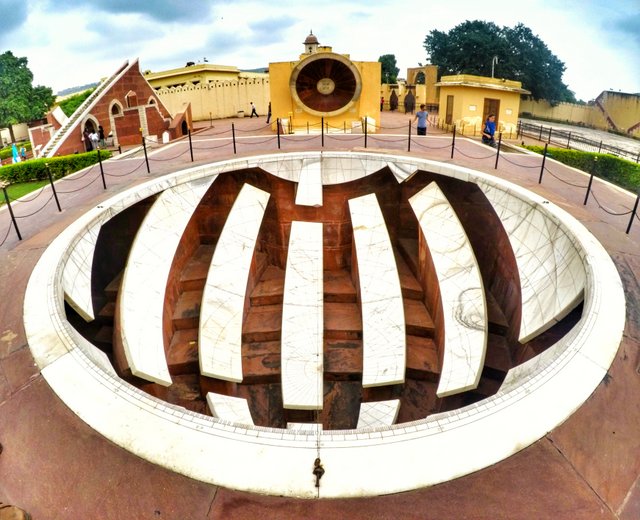
This is the most intriguing yantra here in Jaipur. This is a set of two sunken half spheres in marble. They are non-identical twins cut out in white marble. Yes, that means they would literally complete each other if joined. Each cutting of marble marks an hour. This means every hour the observer can stand in one of the spheres and take measurements.

The heart of this stunning instrument is a small piece of metal with a central hole hanging bang in the middle of the sphere. It is the shadow of this metal piece that tells gives all the answers that you seek from this instrument.
If I may say, this is the most beautiful of all the yantras here. The spherical cut-out balls in white marble against the red sandstone look fascinating. When the guide explains this – astronomy sounds simple and fascinating.
Kapali Yantra
These look like the prototype of Jai Prakash Yantra.
Narivalaya Yantra

This intriguing instrument has two circular plates – one facing North and the other South. The angle of these plates is such that they are parallel to the equator. A small nail-like rod at the center is this parallel to the earth’s axis. The shadow of this rod tells the time.

The southern plate is sunlit from the autumn to spring equinox and the northern one from the spring to the autumn equinox. This essentially means that each of these plates is functional for 6 months of the year.
A Sanskrit inscription on the southern dial tells the story of the conservation and renovation of this Narivalaya Yantra. It is very interesting, how first the Lord Ganesha is remembered, then the purpose of the instrument is explained, then the curiosity of the ancestor who built it is acknowledged before getting into the details of the renovation. I wish ASI translates it for visitors.
Raj Yantra

This is a large metal disc made of Ashtdhatu with the Nakshatras or constellations marked on it. Technically, it is called Astrolabe.
We had great fun at Raj Yantra. As soon as my eyes touched Raj Yantra – I read Rohini written in Devanagari script. I looked around and found some more names of Nakshatras written. Now, I am also named after a Nakshatra, and hence began our search for my name on the Raj Yantra. With a bit of help from Google, we found it almost at the top right of the disc. Believe me, I was on top of the world as soon as we found Anuradha written on Raj Yantra. Our guide, Dinesh Ji, took us more seriously from this point onwards and spent good 3 hours showing and explaining the rest of the place to us.
There are two hanging discs at Raj Yantra – one of them is a prototype potentially in iron and the second is the one I talk about above.
Raj Yantra is used once a month to work out the Indian Calendar.
Rasivalaya Yantra

Rasivalaya Yantra is made of 12 yantras – one each for a zodiac sign. These measure the transition of the zodiac through the Meridien. Each instrument looks similar and has a resemblance to Samrat Yantra but each is mathematically different. This instrument is found only here.
On an ego trip, I just looked at the instrument of Scorpio in detail.
Ram Yantra

Ram Yantra is a lovely instrument. I remember Ram Yantra from Delhi Jantar Mantar which is lovely in Red color.
Ram Yantra measures the altitude and azimuth of celestial objects.

- Digamsa Yantra – This cylindrical yantra measures the azimuth of celestial objects.
- Kranti Vritt Yantra – Used to measure the latitude and longitude of celestial bodies.
Shashthansh Yantra
This is a 60 deg arch located next to the Vrihat Samrat Yantra. When you go inside the arch, sunlight enters the dark chamber through a hole and this is used to measure the distance from the sun.
Standing inside when you look at a small dot on the wall you bow your head in admiration for the architects of this observatory.
Chakra Yantra

The Chakra Yantra is a large metallic ring. I could not gather its purpose except that it is used to look at the sky.
Prototypes or Test Models of all Yantras at Jantar Mantar

For me, a fascinating part was the prototypes of each instrument. They kind of tell you the experiments that went behind building these precise instruments. You can see smaller versions of each instrument. For metal instruments, you can see an experiment with various metals. These prototypes give you the feel of standing in a laboratory.
Each instrument has a staircase for the observers to climb and take accurate readings. As a visitor, you are not allowed to climb any of the instruments.
It made me wonder if I should have indeed chosen a career in Physics – which is what I majored in.
All big walls have arches below them – both to manage the weight of the wall and add to the contemporary aesthetics of the times. The place would be a bit boring without these arched windows.
It is a fascinating place in Jaipur. All the instruments look so simple that you wish you could build them at home. But, as they say, it takes a lot of expertise to make the complicated look simple.
Travel Tips for Jantar Mantar, Jaipur

- Jantar Mantar at Jaipur is a UNESCO World Heritage Site. It is open from sunrise to sunset – precisely the time yantras inside this complex work.
- The ticket at the time of writing is Rs 50/- for Indians and Rs 200/- for Foreigners.
- It is located bang in the middle of Jaipur city, with access to everything that you can possibly require.
- On average visitors spend 45 mins to an hour at this place. I spent 3 hours and I think there are a few yantras I skipped. So, plan according to your interest in the sky and its mysteries.
- If like me you are named after a Nakshatra – find out your name on Raj Yantra. Here is the list of Nakshatras for you.
- Make sure the Sun is shining bright when you visit, to have the best experience.
- Highly recommend hiring a good guide. Our guide Sh Dinesh Sharma (85598 93399) was very good & gave us insights into each instrument.
- Check out this interesting website .
- It is a great place to take the children with you.
Other UNESCO World Heritage Sites in Golden Triangle Tourist Circuit
- TAGS
- Heritage Monuments
- Modern India
- Rajasthan Travel
- World Heritage


